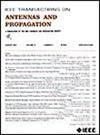A Dual-Polarized Fixed-Frequency Beam-Scanning Leaky Wave Antenna for 5 G Millimeter-Wave Applications
IF 5.8
1区 计算机科学
Q1 ENGINEERING, ELECTRICAL & ELECTRONIC
引用次数: 0
Abstract
In this article, a dual-polarized (DP) fixed-frequency beam-scanning leaky wave antenna (LWA) is presented. Operating from 24.5 to 27.5 GHz, the LWA consists of a vertically polarized (VP) patch array, a horizontally polarized (HP) printed dipole array, and a dual-channel gap waveguide (GW) that provides traveling-wave excitation. The VP patch array, located at the center of the antenna aperture, contains 80 slot-excited patches. The HP dipole array is divided into two subarrays distributed on both sides of the antenna aperture and is excited by slot-coupled microstrip lines. The VP and HP arrays are independent, enabling simultaneous control of both polarization beams. Due to the low profile of the printed dipole, the radiation aperture of the antenna can be fully utilized, providing the ability to expand in two dimensions. To achieve fixed-frequency beam scanning, each antenna unit has a 1-bit amplitude modulation capability, realized by electrically controlling the p-i-n diode. A dual-channel GW capable of transmitting both TE01 and TE10 modes is designed, and the stacked architecture makes it suitable for a compact DP antenna. A holographic method is employed to realize the beam scanning. Simulated and measured results verify that the proposed antenna can achieve fixed-frequency, wide-angle, and quasi-continuous beam scanning.用于5g毫米波应用的双极化固定频率波束扫描漏波天线
本文提出了一种双极化固定频率波束扫描漏波天线。LWA的工作频率为24.5至27.5 GHz,由垂直极化(VP)贴片阵列、水平极化(HP)印刷偶极子阵列和提供行波激励的双通道间隙波导(GW)组成。VP贴片阵列位于天线孔径中心,包含80个缝隙激励贴片。高压偶极子阵列分为分布在天线孔径两侧的两个子阵列,由狭缝耦合微带线激励。VP和HP阵列是独立的,可以同时控制两个偏振光束。由于印刷偶极子的低轮廓,可以充分利用天线的辐射孔径,提供在二维扩展的能力。为了实现固定频率波束扫描,每个天线单元具有1位调幅能力,通过电控p-i-n二极管实现。设计了一种能够同时传输TE01和TE10模式的双通道GW,其堆叠结构使其适合于紧凑的DP天线。采用全息方法实现光束扫描。仿真和实测结果验证了该天线能够实现定频、广角、准连续波束扫描。
本文章由计算机程序翻译,如有差异,请以英文原文为准。
求助全文
约1分钟内获得全文
求助全文
来源期刊
CiteScore
10.40
自引率
28.10%
发文量
968
审稿时长
4.7 months
期刊介绍:
IEEE Transactions on Antennas and Propagation includes theoretical and experimental advances in antennas, including design and development, and in the propagation of electromagnetic waves, including scattering, diffraction, and interaction with continuous media; and applications pertaining to antennas and propagation, such as remote sensing, applied optics, and millimeter and submillimeter wave techniques

 求助内容:
求助内容: 应助结果提醒方式:
应助结果提醒方式:


